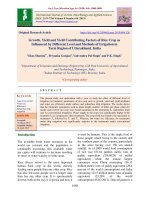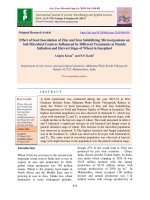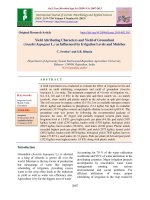Growth parameters of summer bajra at different phenological stages as influenced by irrigation
Bạn đang xem bản rút gọn của tài liệu. Xem và tải ngay bản đầy đủ của tài liệu tại đây (185.45 KB, 7 trang )
Int.J.Curr.Microbiol.App.Sci (2018) 7(7): 2923-2929
International Journal of Current Microbiology and Applied Sciences
ISSN: 2319-7706 Volume 7 Number 07 (2018)
Journal homepage:
Original Research Article
/>
Growth Parameters of Summer Bajra at Different Phenological Stages as
Influenced by Irrigation
P. Ashok¹*, K.P. Vani1, K.B. Suneeta Devi2 and P. Surendra Babu3
1
Department of Agronomy, College of Agriculture, PJTSAU, Hyderabad, Telangana, India
2
Department of Agronomy, College of Agriculture, Jagtial, PJTSAU, Telangana, India
3
Agronomy, AICRP on Micronutrients, Agriculture Research institute, PJTSAU,
Rajendranagar, Hyderabad, Telangana, India
*Corresponding author
ABSTRACT
Keywords
Growth Parameters
Summer Bajra
Phenological Stages
Irrigation
Article Info
Accepted:
20 June 2018
Available Online:
10 July 2018
A field experiment was conducted under sandy loam soil during the summer season of
2018 at College Farm, College of Agriculture, Professor Jayashankar Telangana State
Agricultural University, Rajendranagar, Hyderabad. The experiment comprised of nine
irrigation treatments namely, I1 {Irrigation at Tillering (T) + Panicle initiation (PI) +
Flowering (F) + Grain filling (GF)}, I2 {Irrigation at Tillering (T) + Panicle initiation (PI)
+ Flowering (F)}, I3 {Irrigation at Tillering (T) + Panicle initiation (PI) + Grain filling
(GF)}, I4 {Irrigation at Tillering (T) + Flowering (F) + Grain filling (GF)}, I 5 {Irrigation at
Panicle initiation (PI) + Flowering (F) + Grain filling (GF)}, I6 {Irrigation at Tillering (T)
+ Flowering (F)}, I7 {Irrigation at Tillering (T) + Grain filling (GF)} I 8 {Irrigation at
Panicle initiation (PI) + Grain filling (GF)} and I 9 {Irrigation at Flowering (F) + Grain
filling(GF)}, were replicated three times in a randomized block design. Results showed
that I1 recorded significantly maximum values of growth parameters (plant height, leaf
area index, SPAD readings, number of tillers m-2 and days to 50% flowering). From this
investigation it can be concluded that, out of nine treatments, I1 was ideal for realizing
growth parameters at harvest.
Introduction
Pearl millet (Pennisetum glaucum) is a species
of the millet family also known as bulrush,
spiked or cat-tail millet, it is the most drought
tolerant cereal grown in the arid and semi-arid
regions of the world. Globally, pearl millet is
consumed in different forms: unleavened
bread (roti or chapatti), porridge and gruel and
hence it is often referred to as poorman’s
bread (Burton et al., 1972).India is the largest
producer of pearl millet in the world
occupying 7.129 million hectares with annual
production of 8.067 million tonnes and
average productivity of 1132 kg ha-1 (Ministry
of Agriculture and Farmers Welfare, Govt. of
India, 2017). In Telangana it is grown on 0.05
lakh hectares with 0.04 lakh tonnes of
production and productivity of 824 kg ha-1
(Department of agriculture, Telangana, 2016-
2923
Int.J.Curr.Microbiol.App.Sci (2018) 7(7): 2923-2929
17). Pearl millet grain is more nutritious and
the grain contains 11-19 % protein, 60-78%
carbohydrates and 3.0-4.6% fat and also has
good amount of phosphorous and iron
(Reddy et al., 2016). In addition to grain, pearl
millet is also used as cattle feed, poultry feed
and source of starch in the alcohol industry. Its
fodder is an important source of animal feed
particularly in dry months when alternative
sources of feed are not available.
The productivity of pearl millet in India is
very low as compared to important pearl
millet growing countries in the world. It is,
therefore, necessary to increase the production
and productivity of pearl millet by adopting
scientific innovations like proper water
management technique for optimum crop
production. Under water shortage conditions,
water could be reserved for irrigation during
the critical growth stages (Seghatoleslami et
al., 2008). In kharif the pearl millet is
cultivated under rainfed conditions with lowinput-low-output management, while summer
pearl millet is cultivated under high-inputhigh-output management. Due to climate
change, yield of kharif crop is adversely
affected that’s why area under summer pearl
millet is increasing. High grain and fodder
yield of better quality and greater water-use
efficiency combined with tolerance to heat
during flowering and grain development (air
temperature during flowering can exceed
42°C) are the reasons for cultivating pearl
millet in the summer season (Upadhyay et al.,
2001).
There is a need to explore opportunities to
expand the area under summer pearl millet
particularly in areas where irrigation is
available and the fields are vacant during the
summer season. Even though the adaptation of
millet to the driest environments is realized, its
vegetative response to water deficits has not
been clearly described. Considering these facts
in view, an irrigation experiment on summer
pearl millet (Pennisetum glaucum L.) was
planned to evaluate growth parameters.
Materials and Methods
Field experiment was carried out in sandy
loam soil at College Farm, College of
Agriculture, Professor Jayashankar Telangana
State Agricultural University, Rajendranagar,
Hyderabad. The pH of the experimental site
was 7.8, organic carbon was 0.63%, available
nitrogen, phosphorus and potassium were 175
kg ha-1, 64 kg ha-1 and 352 kg ha-1
respectively.
The experiment comprised of nine irrigation
treatments namely, I1 {Irrigation at Tillering
(T) + Panicle initiation (PI) + Flowering (F) +
Grain filling (GF)}, I2 {Irrigation at Tillering
(T) + Panicle initiation (PI) + Flowering (F)},
I3 {Irrigation at Tillering (T) + Panicle
initiation (PI) + Grain filling (GF)}, I4
{Irrigation at Tillering (T) + Flowering (F) +
Grain filling (GF)}, I5 {Irrigation at Panicle
initiation (PI) + Flowering (F) + Grain filling
(GF)}, I6 {Irrigation at Tillering (T) +
Flowering (F)}, I7 {Irrigation at Tillering (T)
+ Grain filling (GF)} I8 {Irrigation at Panicle
initiation (PI) + Grain filling (GF)} and I9
{Irrigation at Flowering (F) + Grain
filling(GF)}, were replicated three times in a
randomized block design. Pearl millet was
sown on 19th January, 2018 and harvested on
30th April, 2018 During the growing season,
the mean weekly maximum, minimum
temperature, relative humidity, sunshine hour
day-1 and evaporation were 34.2 ºC, 16.2 ºC,
78.4%, 25.5%, 8.36 hrs dy-1 and 5.46mm.
Pearl millet was sown at a spacing of 45 cm x
15 cm using seed rate of 4 kg ha-1.The field
was uniformly irrigated on the day of sowing.
Further, one irrigation was given at 10 days
after sowing. Further irrigations were given
based on the treatments. 50 mm depth of
irrigation water was applied at each irrigation.
The RDF i.e. Nitrogen (80 kg ha-1) was
2924
Int.J.Curr.Microbiol.App.Sci (2018) 7(7): 2923-2929
applied through urea in two equal splits, first
as basal and the remaining dose at 30 DAS
(days after sowing, whereas full dose of P2O5
(40 kg ha-1) and full dose of K2O (30 kg ha-1)
were applied through SSP and muriate of
potash respectively, as basal dose to all the
experimental plots.
Five plants were randomly selected in each net
plot and tagged permanently. From these five
plants growth parameters like plant height,
SPAD readings and number of tillers were
recorded. Leaf area is taken from the plants
collected for dry matter production using LI
3000 portable area meter with transparent
conveyor belt utilizing an electronic digital
display. For all these growth parameters data
was collected at different phenological stages
i.e. tillering flowering grain filling and at
harvest. Number of days taken from sowing to
50 per cent flowering was recorded in each
treatment. By using the data of leaf area, LAI
was calculated using following formula
Leaf area (cm2)
LAI = ----------------------------Unit ground area (cm2)
Results and Discussion
I1recorded significantly highest plant height of
175 cm followed by I3 (164.5cm) and I4 (162.2
cm) though at par with each other and
significantly superior over the rest of the
treatments. While irrigation treatment, I9
(116.9 cm) recorded significantly the lowest
plant height. Such a positive response might
be due to increase in number of irrigations,
which raised the moisture status of the soil and
availability of soil moisture to the crop plant.
These findings are in agreement with Vyas et
al., (1992) and Sakellariou- Makrantonakiet
al., (2007).
Leaf area index
Leaf area index revealed that it increased with
advancement in growth stages till grain filling
and gradually decreased towards harvest. Leaf
area index had not differed significantly due to
application of irrigations at tillering stage.
Among the different nine irrigation levels, I1,
I2 and I3 recorded significantly higher leaf area
index, (3.45, 3.4 and 3.37) though at par with
each other compared to the rest of the
irrigation treatments at flowering stage.
Similar trend of significantly higher LAI was
observed at grain filling stage with I1 (3.95)
and I2 (3.89) followed I3 (3.54) and I4 (3.49)
compared to the rest of the treatments.
Plant height (cm)
It is apparent from the data (Table 1) that plant
height significantly differed due to irrigations
at all the stages of crop growth except at
tillering stage. At flowering stage I1 treatment
had significantly produced taller plants of
133.4 cm followed by I2 (127.3 cm) and I3
(125.1 cm) which are on par with each other
and significantly superior over other
treatments.
At grain filling stage, the I1 and I2 had
recorded maximum plant height of 152 and
149 cm and were on par with each other.
Lowest value was observed in I9. At harvest
At both the stages, i.e. at flowering (2.01) and
grain filling (2.45) I9 recorded the lowest leaf
area index. Leaf area index (LAI) is the main
physiological determinant of the crop yield. at
harvest stage I1 had significantly produced
more LAI of 2.75 followed by I3 (2.44) and I4
(2.42). Lowest LAI of 1.07 was recorded by I9
treatment. Increase in LAI under increased
moisture availability and moisture supply
contributed to more number of green leaves,
size of leaves, etc., which led to higher leaf
area and leaf area index. These results were in
close proximity to those of Saren et al., (2004)
(Table 2).
2925
Int.J.Curr.Microbiol.App.Sci (2018) 7(7): 2923-2929
Table.1 Growth parameters of summer pearl millet as influenced by irrigations at different phenological stages
Treatments
Plant height (cm)
Leaf area index
SPAD readings
T
F
GF
H
T
F
GF
H
T
F
GF
H
I1
52.5
133.4 a
152 a
175 a
1.55
3.45 a
3.95 a
2.75 a
31.6
49.2 a
45.7 a
39.8 a
I2
49
127.3 a
149 a
151.4 c
1.50
3.40 a
3.89 a
2.11 c
29.2
48.9 a
43.5 a
33.2 c
I3
51.6
125.1a
135.4 b
164.5 b
1.53
3.37 a
3.54 b
2.44 b
31.5
47.5 a
39.6 b
37.1 b
I4
51
115.4 b
139 b
162.2 b
1.44
2.59 b
3.49 b
2.42 b
30.3
42.9 b
38.3 b
36.3 b
I5
45.3
103.3 c
122.1 c
129 e
1.52
2.33 c
3.14 c
1.47 e
28.0
38.0 c
34.2 c
26.0 e
I6
46
114.6 b
136.2 b
141 d
1.41
2.70 b
3.57 b
1.81 d
29.6
42.3 b
37.5 b
30.1 d
I7
44.4
115.1 b
120.3 c
139.2 d
1.42
2.69 b
2.86 c
1.79 d
28.8
41.1 b
30.1 c
28.8 d
I8
47
102.5 c
110.5 d
118.8 f
1.37
2.32 c
2.53 d
1.12 f
29.0
36.4 c
27.4 d
23.3 f
I9
48.1
87 d
107.7 d
116.9 f
1.38
2.01 d
2.45 d
1.07 f
28.5
33.5 d
26.2 d
21.4 f
Mean
48.32
113.7
130.24
144.23
1.46
2.76
3.27
1.89
29.64
42.2
35.83
30.67
S. Em. +/-
1.80
2.92
3.12
3.19
0.06
0.08
0.09
0.08
0.8
0.97
0.92
0.89
CD (5%)
NS
8.76
9.35
9.58
NS
0.25
0.27
0.24
NS
2.81
2.75
2.67
Tillering, F - Flowering, GF - Grain filling, H - Harvest
2926
Int.J.Curr.Microbiol.App.Sci (2018) 7(7): 2923-2929
Table.2 Growth parameters of summer pearl millet as influenced by irrigations
Number of tillers m-2
Treatments
T
F
GF
H
Days to
50%
flowering
I1
39.7
57.3 a
52.2 a
46.5 a
50 a
I2
37.2
56.8 a
51.7 a
39.6 c
49 a
I3
38.8
56.1 a
48.3 b
43.1 b
51 a
I4
36.0
52.0 b
46.2 b
42.8 b
55 b
I5
37.0
46.8 c
37.8 c
32.1 e
62 c
I6
36.7
51.8 b
45.5 b
36.4 d
56 b
I7
I8
35.6
37.0
50.9 b
45.5 c
40.1 c
28.5 d
35.8 d
25.3 f
57 b
60 c
I9
34.7
40.8 d
26.8 d
23.9 f
69 d
Mean
S. Em. +/CD (5%)
37.0
0.97
NS
50.9
1.22
3.68
41.9
1.03
3.08
36.2
0.92
2.77
56.56
0.86
2.58
T - Tillering, F - Flowering, GF - Grain filling, H - Harvest
SPAD readings
SPAD readings at tillering stage were found
to be statistically insignificant. However, at
flowering stage, the significantly higher
SPAD values (49.2) were recorded under
I1treatmentand was followed by I2(48.9) and
I3(47.5), while the lowest SPAD values of
33.5 was noticed by I9. At grain filling stage,
the SPAD values started declining and among
the nine treatments, I1 treatment recorded the
significantly higher value of 45.7 which was
followed by I2 (43.5) and lowest SPAD values
of 27.4 were recorded by I9. At harvest stage
SPAD values declined compared to the
previous growth stages. 39.8 value of SPAD
was noticed with I1 treatment which was
significantly superior to I3 (37.1) and I4 (36.3)
though on par superseding I2 (33.2). The
lowest SPAD values were shown by I9 and I8
which were statistically at par with each other
(21.4 and 23.3). Significantly higher values of
SPAD may be attributed to better root growth,
resulting in higher water and nutrient uptake
which resulted in increased chlorophyll
content in leaves. Gonzalez et al., (2009)
reported total chlorophyll was higher under
irrigation scheduled at two-day interval
compared to continuous drought and water
stress.
Number of tillers m-2
Non-significant variation in number of tillers
m-2was observed due to effect of nine
irrigation treatments at tillering stage.
However, I1 treatment recorded maximum
number of tillers m-2 (57.3) followed by I2and
2927
Int.J.Curr.Microbiol.App.Sci (2018) 7(7): 2923-2929
I3 with 56.8 and 56.1 tiller number which
were at par with each other. Lowest number
of tillers m-2 was observed with I9 treatment
(40.8). At grain filling stage, significantly
maximum number of shoots were noticed
with I1 (52.2) and I2 (51.7) and were followed
by I3 (48.3), I4 (46.2) and I6 (Irrigation at
Tillering + Flowering) (45.5) which were
statistically at par but differed significantly
with the rest of the treatments. Minimum
number of tillers m-2 were recorded with I9
treatment (26.8). At harvest stage I1 treatment
significantly recorded higher number of tillers
(46.5) followed by I3 (43.1) and I4(42.8)
which were significantly superior over other
treatments, while I9 treatment (23.9) produced
the lowest number of tillers. The higher
number of tillers might be due to enhanced
cell expansion and various metabolic
processes in the presence of abundant supply
of moisture which resulted into increased
tillering.The results confirms the findings of
Singh et al., (2012).
Days to 50% flowering
Days to 50% flowering was significantly
influenced by Irrigation at tillering and
panicle initiation. The irrigation treatments I1
(50), I2 (49) and I3 (51) taken significantly
lower number of days to 50% flowering
followed by I4 (55) and it was on par with I6
(56) and I7 (57). Significantly longer period
was taken by the crop for 50% flowering in I9
with 69 days. The crop has taken more
number of days for 50% flowering where the
irrigation was skipped at tillering and panicle
initiation stage. It is due to moisture stress at
early stages caused poor development of crop.
These findings are in accordance with Fukai
et al., (1994).
References
Burton, G.W., Wallace, A.T and Rachie, K.O.
1972. Chemical composition and
nutritive value of pearl millet
[Pennisetum
typhoides
(burm.)
stapfand E. C. Hubbard] grain. Crop
Science. 12: 187–188.
Department of Agriculture, Telangana, 201617.
Fukai, S and Lilley, J.M. 1994. Effects of
timing and severity of water deficit on
four
diverse
rice
cultivars.
phenological dev, crop growth and
grain yield. Field Crops Research. 37:
225-234.
Gonzalez, J.A., Gallardo, M., Hilal, M., Rosa,
M.,
and
Prado,
F.E.
2009.
Physiological responses of quinoa
(Chenopodium quinoa Willd.) to
drought and waterlogging stresses, dry
matter partitioning. Botanical Studies.
50: 35-42.
Ministry of Agriculture and Farmers Welfare,
Govt. of India, 2017.
Reddy, S.B.P., Naga madhuri, K.V., Keerthi
Venkaiah and Prathima, T. 2016.
Effect of nitrogen and potassium on
yield and quality of pearl millet
(Pennisetum
glaucum
L.)
International Journal of Agriculture
Innovations and Research. 4(4): 678681.
Sakellariou-Makrntonaki, M., Papalexis, D.,
Nakos, N and Kalavrouziotis, I.K.
2007. Effect of modern irrigation
methods on growth and energy
production of sweet sorghum (var.
Keller) on adry year in Central
Greece.
Agricultural
Water
Management. 90: 181-189.
Saren, B.K., Dey, S and Mandel, D. 2004.
Effect of irrigation and sulphur on
yield
attributes,
productivity,
consumptive use, consumptive use
efficiency
of
wheat
(Trtitcum
aestivum).
Indian
Journal
of
Agricultural Sciences. 74(5): 257-261.
Seghatoleslami, M.J. Kafi, M and Majidi, E.
2008. Effect of deficit irrigation on
2928
Int.J.Curr.Microbiol.App.Sci (2018) 7(7): 2923-2929
yield, WUE and some morphological
and phenological traits of three millet
species.
Singh, L., Singh, C.M and Singh, G.R. 2012.
Response of bed planted wheat
(Tritcum aestivum L.) under different
moisture regimes on water use and its
efficiency. Journal of Chemical and
Pharmaceutical Research. 4(11):
4941-4945.
Upadhyay, P.N., Dixit, A.G., Patel, J.R and
Chavda, J.R. 2001. Response of
summer pearl millet (Pennisetum
glaucum) to time and method of
planting, age of seedling and
phosphorous grown on loamy sand
soils of Gujarat. Indian Journal of
Agronomy. 46 (1): 126-130.
Vyas, S.H., Patel, J.C., Patel, B.S. and
Sukhadia, N. 1992. Response of
summer pearl millet (Pennisetum
glaucum) to irrigation nitrogen and
phosphorus. Indian Journal of
Agronomy. 37 (4): 819-821.
How to cite this article:
Ashok, P., K.P. Vani, K.B. Suneeta Devi and P. Surendra Babu. 2018. Growth Parameters of
Summer Bajra at Different Phenological Stages as Influenced by Irrigation.
Int.J.Curr.Microbiol.App.Sci. 7(07): 2923-2929. doi: />
2929



![Growth and yield of Ashwagandha [Withania somnifera (L.)] as influenced by different intercropping system in Kymore plateau of Madhya Pradesh](https://media.store123doc.com/images/document/2020_01/09/medium_vsb1578562778.jpg)





